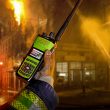Motorola wins campus contracts at Chinese universities
The China Education and Research Network (CERNET) has chosen Motorola’s HotZone Duo solution to provide public Wi-Fi access on three university campuses as part of a pilot program, the vendor giant announced this week.
Featuring dual radios operating in the 2.4 GHz and 5.8 GHz bands, the HotZone Duo was the only solution to date that has met CERNET’s criteria China’s Next Generation Internet (CNGI) project, including support of the new IPv6 protocol, said Peter Stanforth, director of technology for Motorola’s mesh-networks product group.
Keying the success of the HotZone Duo—which typically uses a 2.4 GHz radio for access and 5.8 GHz for backhaul—is the fact that Motorola’s mesh-routing protocols are contained in Layer 2 instead of Layer 3, Stanforth said.
“All of these [CERNET requirements] like IPv6, the security and quality-of-service capabilities run at Layer 3, so it was all pretty transparent and fairly easy for us to comply with their requirements,” he said.
As part of a five-year plan, China’s Ministry of Education is deploying high-speed wired connectivity at all the universities in the country, so there is adequate backhaul to support wireless infrastructure, Stanforth said. Ultimately, China wants to provide wireless broadband access to students and teachers at 1300 universities nationwide.
“I’m sure we’re not going to get all 1300, if only because the Chinese government is going to keep trying until someone else passes the test, because they’re going to want some competitiveness in that whole process,” Stanforth said. “Having passed the test first, hopefully, we’ll get the lion’s share, but it’s reasonable to expect that we’d get all of them.”
CERNET represents the first Motorola mesh deployment focused solely on university/research access, although some citywide deployments also have included college campuses, Stanforth said.

















